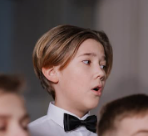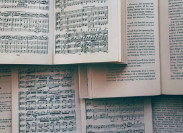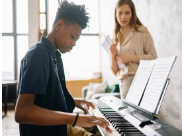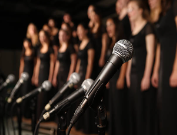The standards for Middle School Choral Music, Beginning Level enable students to obtain musical knowledge and skills in the choral setting. Students begin to develop choral skills, including singing in unison and two-part harmony, with emphasis on vocal production and technique. They learn to read, write, and notate music using basic music theory concepts and perform music from a variety of music styles, composers, cultural influences, and historical periods. Students identify the steps of a creative process and apply emerging music skills to create and notate original work. Students examine career options in music and identify the relationship of choral music to other fine arts. Opportunities are provided for students to participate in local and district music events as appropriate to level, ability, and interest. Performances are an important part of group activities. After-school rehearsals and public performances may be required of students. Membership is based on interest; there is no audition required.
No Prerequisite Required
Essential Question: How do I connect with, respond to, perform, and create music?
|
Quarter |
Quarter 1 |
Quarter 2 |
Quarter 3 |
Quarter 4 |
|
Unit Title |
Who am I in Chorus? |
Read, Write, Perform |
Keys to Success |
Getting Ready for the Big Leap |
|
Image Cue |

|

|

|

|
|
Focus of the Story |
We begin the year focusing on chorus classroom procedures, routines, and ensemble building using vocal rounds, 2 and 3-part harmony and building our musicianship skills by reviewing key terminology that helps us describe what music looks like and sounds like. We will also be learning how to prepare for an audition and exploring more complex technical skills, while sight-reading and singing new literature. |
We will continue to study rhythm through dictation and composition and challenge ourselves with more rigorous sight reading levels and keyboarding skills. Through the study of music literacy, performance, and the discussion of musical eras, we will examine the relationship of choral music to other fine arts and core subjects through our Winter Concert repertoire. |
In this quarter, we learn that there is value in all productions and that performances should be critiqued based on the characteristics of the time period and style. Students may participate in a District Assessment performance and will critique their own performance based on adjudicator feedback using music terminology and utilizing classroom technology. |
We end the year with a culminating solo project utilizing learned literacy and performance skills. The students will learn a song using developed keyboarding skills to prepare and perform a solo and the repertoire we will perform in the Spring Concert. We will also discuss music citizenship looking at how music affects our daily lives. |
|
Transfer Goals |
Understand and apply creative processes to guide the development of ideas, original works, and musical performance. Understand and find meaning in music as a form of community engagement through involvement as a performer, supporter, advocate, and audience member. Explore and connect personal interests, experiences, and aspirations through vocation, advocacy, and arts patronage. Use music literacy to demonstrate understanding of the elements of music and the ways they inform artistic performance and creative expression. |
Understand and apply creative processes to guide the development of ideas, original works, and musical performance. Analyze, interpret, and evaluate musical works from a variety of cultures. Understand and find meaning in music as a form of community engagement through involvement as a performer, supporter, advocate, and audience member. Explore and connect personal interests, experiences, and aspirations through vocation, advocacy, and arts patronage. Use music literacy to demonstrate understanding of the elements of music and the ways they inform artistic performance and creative expression. |
Understand and apply creative processes to guide the development of ideas, original works, and musical performance. Analyze, interpret, and evaluate musical works from a variety of cultures. Understand and find meaning in music as a form of community engagement through involvement as a performer, supporter, advocate, and audience member. Explore and connect personal interests, experiences, and aspirations through vocation, advocacy, and arts patronage. Use music literacy to demonstrate understanding of the elements of music and the ways they inform artistic performance and creative expression. Use technology as a strategic mechanism for improving music literacy and improving music performance. |
Understand and apply creative processes to guide the development of ideas, original works, and musical performance. Analyze, interpret, and evaluate musical works from a variety of cultures. Understand and find meaning in music as a form of community engagement through involvement as a performer, supporter, advocate, and audience member. Explore and connect personal interests, experiences, and aspirations through vocation, advocacy, and arts patronage. Curate a portfolio of accomplishments, experiences, and performance materials exhibiting oneself as an artist. Use music literacy to demonstrate understanding of the elements of music and the ways they inform artistic performance and creative expression. Use technology as a strategic mechanism for improving music literacy and improving music performance. |
|
Learning Targets |
I can summarize and define the procedures for the chorus classroom. I can collaborate with my classmates. I can relate to my classmates and define traits which we share and those we do not. I can recall and apply solfege and Kodaly hand signs. I can identify the music symbols and key vocabulary within a vocal score. I can identify and write notes and rests. I can self-assess my success with posture, collaboration, and rehearsal skills. I can identify the parts of a music score. I can sing vocal exercises with the ensemble and individually. I can perform the District Audition piece in accordance with the grading rubric. I can evaluate and reflect on my goals for Quarter 1. |
I can compose an eight measure rhythmic composition. I can sing expressively. I can sight read four measures. I can demonstrate active listening as an audience member. I can dictate a four measure rhythmic example. I can identify the time periods of concert repertoire. I can explore music from different cultures. I can exercise ethical consumption of music. I can label the black and white keys on the piano. |
I can identify the key signatures of C, F, and G. I can sing the spring concert/ assessment repertoire. I can evaluate and critique skills by listening to choral performance recordings. I can sight read with vocal independence. I can play the keyboard using simple 8 measure melodies on level 1 of Sight Reading Factory. I can improvise 8 beats of melody that start and end on do and include a do-sol skip. I can dictate 16 beats (drmfs) of melody. I can utilize music technology to create music. I can discuss the importance of music in my own life. |
I can prepare for the Spring Concert by singing expressively. I can demonstrate proper audience and performance etiquette, collaboration and communication skills with my ensemble. I can discuss music’s role in society and how our concert contributes to society. I can identify and give examples of careers in music. I can perform the vocal part from a Spring Concert piece on the keyboard. I can sing the concert repertoire with appropriate ensemble technique. I can form personal responses to music and performances. I can demonstrate appropriate audience etiquette. I can critique a performance using the VCDA rubric. I can identify how music creates the whole person as well as how music is valuable to the community. I can outline, plan, and prepare for a solo performance by identifying parameters and expectations of my solo performance project. I can respond to peer performances in an appropriate manner. I can identify and explore how media is used to create and edit music. I can reflect on my solo performance, reflect on the school year, and submit a final assessment to display growth over the year. |
